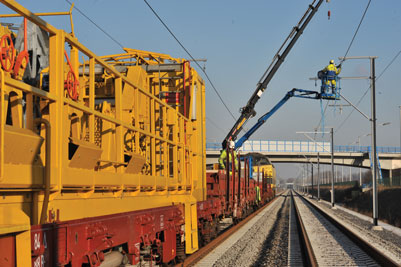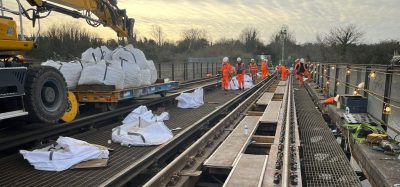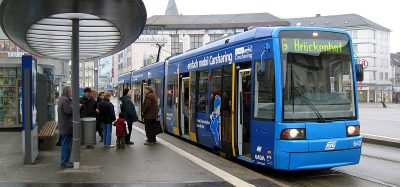Infrabel continues overhead line modernisation work
Posted: 12 February 2014 | | No comments yet
Infrabel, the Belgian rail infrastructure manager, is currently engaged in the progressive modernisation of its overhead lines. Electrical power is a vital element of sustainable rail transport. For Global Railway Review, Richard Marcelis, Head of Infrabel’s Power Engineering Department, explains the major challenges and projects relating to overhead lines on the Belgian network.


Approximately 3,024km of the 3,592km of rail lines on the Belgian network are electrified
Belgium has one of the most sustainable European rail networks
Overhead lines can be seen as standard technology. All over the world, they are the ideal way to supply power to electric trains. Naturally, this also applies to Infrabel which has one of the greenest and most sustainable rail networks in Europe. Approximately 3,024km (or almost 85%) of the 3,592km of rail lines in the Belgian network are electrified.
Infrabel also has a database containing lots of data about the state of its network. Based on this, in addition to an active maintenance policy, it is investing in the modernisation of overhead lines where necessary. Infrabel also keeps a close eye on all developments and incorporates any new or innovative techniques into its overhead line strategy.
Re-electrification of the Brussels strategic rail hub
The electrification of the Belgian rail network began in 1935 with the 50km stretch between Brussels and Antwerp; a 3kV (3,000 Volt) direct current was chosen. After World War II, the federal government decided on a large-scale electrification plan – using the same technique – for over 500km of main lines on our network. The line between Brussels and Luxemburg was the final element of this action plan that was carried out to the letter.
The Belgian rail network is one of the busiest rail networks in the world. In 2012, 4,534 trains (4,119 passenger trains and 415 goods trains) ran on our network on average every day. An action plan is required as the track installations and overhead lines come under heavy use and the older installations are gradually approaching the end of their life
The multi-annual investment plan 2013-2025, approved by the Belgian Government in July 2013, provides for the re-electrification of the ‘Brussels Star’ – the main hub of the Belgian rail network. By 2025, the overhead line infrastructure for the main rail routes around the capital will be totally modernised. The rest of the Belgian network will be modernised during the next phase.
Carefully thought-out technical decisions within the electrification plan
For this ambitious electrification plan, Infrabel had to make several fundamental technical decisions. The most striking decision is surely the conversion of the line between Namur and Luxemburg to 25kV (25,000 Volt) alternating current. Due to the increased capacity, it is impossible to modernise and expand the current 3kV supply in a cost-effective way.
Another less spectacular and perhaps surprising decision is the retention of the original compound design for lines with a maximum speed of 160km/h. The main reason for this is the robustness of this type of overhead line. Temporary initiatives designed to improve the situation, such as variable distance between droppers and variants of this, have not led to significant improvements in quality.
In the 90s, a fully-controlled heavy direct current overhead line was developed for higher speeds. This design allows excellent collection of current at speeds of up to 200km/h.
For the re-electrification, a conscious decision was made to standardise the components which have already demonstrated their operational efficiency. Rigorous quality control in the selection of suppliers combined with close monitoring during the purchase phase minimises the risk of problems after the component is installed.
New observation, testing and recording car for overhead lines
When assessing the life of the installations, Infrabel is gradually adopting a different approach to conventional periodic maintenance. In order to achieve condition-based maintenance, Infrabel has acquired an observation, testing and recording car currently undergoing testing and approval. From the spring of 2014, this four-axle diesel-hydraulic vehicle will allow visual inspection in highly ergonomic conditions. The ultimate aim is to support the visual inspection with expert systems based on image recognition and analysis.
The car is also equipped with a measuring system to calculate the precise thickness of the contact wire and operates based on lateral laser scanning. Although this imposes restrictions on the speeds in use (up to 50km/h), it has the advantage of being highly accurate: preliminary results show an accuracy of 0.1mm at 35km/h. This special overhead line train complements the systematic measurement of the overhead line network. This is currently achieved by the automatic measurement of geometry and the dynamic measurement of contact forces.
New maintenance policy based on retrospective study
In Infrabel’s Infrastructure Division, maintenance is currently carried out by 420 members of staff divided between the 13 regional maintenance centres in the Belgian rail network. The technical teams have a fleet of 21 specialised multi-functional maintenance vehicles at their disposal to carry out the necessary work on the ground. These overhead line work trains are gradually being replaced with new rolling stock where necessary.
In order to refine the priorities for its new maintenance policy, Infrabel carried out a retrospective study in 2013. The analyses of all incidents – in which rail services were disrupted due to a fault in the overhead line – in the last 10 years were systematically re-examined. These incidents were ranked according to a series of criteria including design, quality and degradation mechanism.
The principal conclusion was that, on very busy stretches of line, the fully-controlled overhead line is subject to a combination of mechanical and electrical stresses, resulting in rapid degradation of the hangers. Some installation instructions were also found to lead to high sensitivity to minor installation errors. Based on this, Infrabel has devised a programme of partial modernisation and adaptation designed to lead to greater robustness.
Another conclusion from this incident analysis is that simplifying maintenance goes hand-in-hand with greater reliability provided that the quality of the components and the design is optimised. In practice, a thorough review is necessary. Infrabel has the necessary experts and know-how to carry out such an analysis. The asset databases are currently being adapted so that they can be made available to the maintenance technicians on the ground.
Benefits of overhead line strategy for Infrabel’s customers
This well-thought-out combined strategy for the maintenance and modernisation of the overhead line installations on the Belgian rail network is in keeping with Infrabel’s priorities. A safe, high-quality and sustainable rail network is all thanks to the delivery of electrical power to the rail operators via a reliable network of overhead lines and other installations. This power drives our customers’ locomotives and carriages as well as improves passenger comfort.
Biography
Richard Marcelis has been Head of the Power Engineering Department at Infrabel since 2003. Prior to this, Richard held different positions within the Belgian railway sector, including Project Leader for railway electrification and construction of high-speed lines and their signalling systems, plus being responsible for central infrastructure workshops. Richard studied at KU Leuven and is a Civil Engineer in Electromechanics (Energy) and is now a visiting Professor in the Energy Department at KU Leuven.






